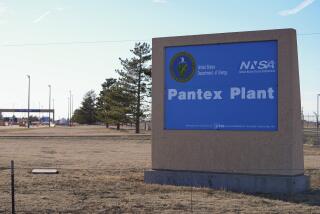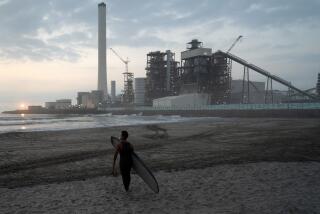Minus Humans, Wildlife Thrives in Chernobyl Area
CHERNOBYL, Ukraine — Ihor Shokhalevich recalls the autumn evening he spotted a boar munching on apples outside the local drugstore.
“He wasn’t bothering anyone,” the Ukrainian biochemist says, smiling at the incongruous image of a tusked pig in what had been the center of a bustling district until the Chernobyl nuclear reactor exploded 10 years ago this April.
Since 135,000 people were evacuated in the disaster’s aftermath, there haven’t been many people for a boar to bother in the highly contaminated “Zone of Alienation” proclaimed around the power station.
Not surprisingly, many people imagine the zone as an irradiated wasteland. In fact, by forcing people to abandon the Rhode Island-size region 60 miles north of the capital, Kiev, the world’s worst nuclear accident has created a new ecological niche.
It is very much alive. “The zone has become a wildlife refuge,” Shokhalevich says.
Large animals, shy around humans, have rebounded. The number of boars has increased eightfold since 1986, when Ukraine was still part of the Soviet Union. The number of moose has doubled. Eagles, cranes and endangered black storks have reappeared. There are also more roebucks, wolves, foxes, otters and rodents than in the region just outside the zone’s 139-mile perimeter.
“And there are no monsters!” insists ecologist Vitaly Gaichenko.
No live monsters, at least. “If wild animals are weak, they die,” he says.
That so many creatures are flourishing leads Gaichenko and other scientists to the surprising conclusion that for wildlife, the benefits of a human-free environment can outweigh even the biological costs of radiation.
No more than 10,000 people are in the entire zone on a given day. And almost all of them are in one of two places named Chernobyl: the atomic energy station, where the two working reactors, which Ukraine promises to close, share a wall with the gutted fourth reactor’s “tomb”; and this eponymous town 12 miles away.
It is here, in decontaminated buildings--they are carpeted in plastic so radioactive dust can be washed off more easily--that the administration of the Zone of Alienation performs its dystopian task of governing a no man’s land.
But in the evenings, when humans leave for lodgings in “clean” areas, a boar can dine, undisturbed, a few blocks from Shokhalevich’s office in the Chernobyl Research and Technical Center. That is, when Olof Eriksson isn’t in town. The sporting Swedish scientist and Ukrainian zoologist Herman Panov bagged more than 60 boars and that many roebucks over three years to see how much radioactivity they were absorbing.
Because zone rules forbid hunting for sport but not hunting for science, the immediate danger to zone animals isn’t from radiation but from researchers on the lookout for guinea pigs.
Eriksson’s study on radiation effects was just one of the hundreds that have been conducted since the April 26, 1986, explosion and fire spewed radiation around the Northern Hemisphere and transmuted the zone into a radiological laboratory. Thirty-two people were killed in the immediate aftermath of the disaster, with the total deaths to date caused by radiation put as high as 10,000.
Cesium and strontium pollute the zone, plus 60,000 square miles in Ukraine and even harder-hit Belarus, which recently put its Chernobyl expenses at $235 billion. But because deadly plutonium--and the byproduct of its radioactive decay, americium--pock the zone, it will be uninhabitable forever unless some way is found to clean it up.
To do that, scientists would first have to determine the exact location of the radionuclides, or radioactive atoms--and tracking them as they move around in the soil, air and water has been a critical part of the first decade of Chernobyl studies.
Some radionuclides are still in surface dust swept by wind gusts. Others are suspended in the zone’s bogs and marshes, like Sunken Pond near the power station, which is the most radioactive spot outside the melted reactor core.
After snowy, frigid winters like this one, spring flooding washes the radionuclides from the pond into the Pripyat River, which carries them into the Kiev reservoir. In 1991, radiation in the reservoir doubled for a few days, causing mild panic despite official assurances that the levels were still safe.
“Fortunately, about 80% of the radionuclides in the zone have sunk about an inch into the topsoil and riverbeds,” says radiochemist Vasyl Lukachyna, who analyzed thousands of samples of soil, water, plants and animal tissue in his shiny laboratory packed with Western equipment.
“They are deep enough not to be spread by the rivers and wind, but they are also traveling very slowly to the ground water,” he explains.
The bad news is that from the soil, radionuclides get into the food chain, migrating into plants, the animals that eat them and the predators, including humans, that eat both.
Once eaten, radionuclides target different organs, where they bombard neighboring cells with atomic particles and, in the case of americium, gamma rays. In bone marrow, which makes blood, the resulting damage can produce leukemia. In ovaries, it can affect future generations.
“But the more we learn, the more we don’t know,” says biologist Viktor Riasenko, who spent five years studying laboratory minks fed contaminated meat that delivered “relatively small doses.” The mink lost their fur within a year, and their numbers shrank with each generation as the young failed to thrive; by the fourth generation, none survived weaning.
Wild animals are also accumulating radionuclides. Eriksson has bagged boars and roebucks with a high rate of internal cesium.
In his study of Chernobyl rodents, American geneticist Robert Baker also found large amounts of cesium--and large numbers of rodents, even in Sunken Pond, where background radiation is 100 times normal. “I was a little surprised at how well living things are doing,” Baker says.
Not all living things. Genetic mutations in some rodents could bode ill for their future. Chernobyl mice have depressed immune systems and, like Riasenko’s minks, die younger and reproduce less. Moose are more often seen with one calf rather than the usual two.
Despite the presence of so many mice and moose and other creatures within the zone, scientists don’t know if those costs won’t eventually come to outweigh the habitat’s human-free benefits.
A “pessimistic optimist,” Riasenko thinks that the diversity and number of animals will decline as the Chernobyl environment winnows out weak species and individuals. But the survivors of the Darwinian struggle, “though fewer in number, will be more resistant to radiation,” he says.
“Evolution in the zone has speeded up,” says ecologist Gaichenko. “But we need at least 20 more years to see the direction it’s taking.”
Time is also needed to understand other effects of the world’s worst nuclear disaster. To this day, for example, the melted reactor core remains a mystery shrouded in lethal radiation. And because radiation’s biological effects become evident over lifetimes, decades must pass before Chernobyl’s impact on human health can be fully appreciated.
To direct the next decade of research, Ukraine is setting up an international scientific center to be financed by the West as part of the compensation to Kiev for the shutdown of the power station’s working reactors.
Shokhalevich thinks that the center will benefit all the countries involved.
“Chernobyl was a tragedy,” he says, with a nod at the radioactive habitat outside his window. “But it created a unique place that can teach the world a great deal.”
More to Read
Sign up for Essential California
The most important California stories and recommendations in your inbox every morning.
You may occasionally receive promotional content from the Los Angeles Times.










